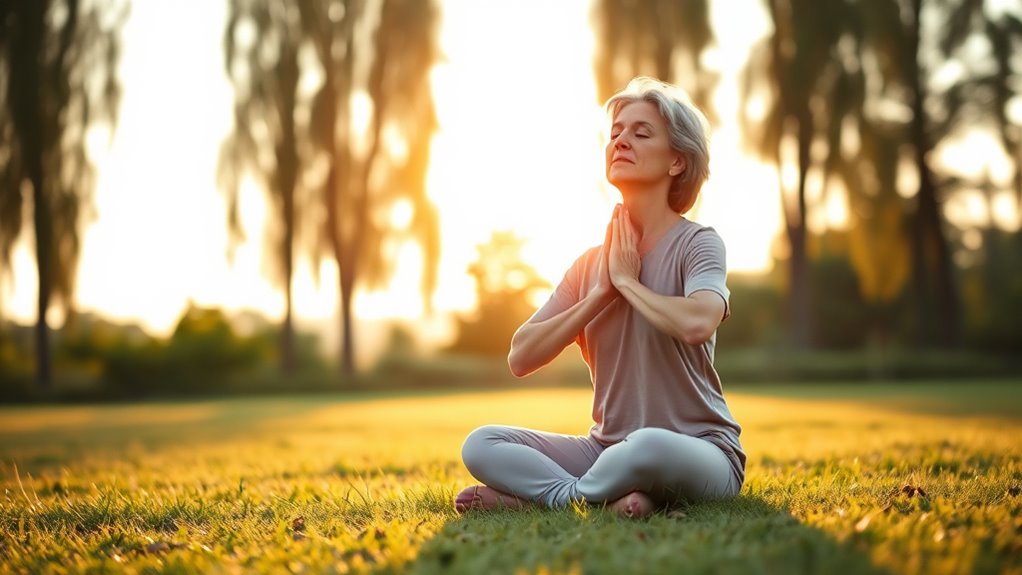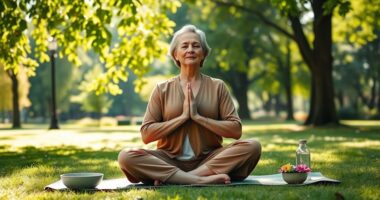As you enter your 40s, yoga combined with mindful breathing and meditation can be a powerful way to reduce stress and boost your overall health. Focusing on slow breaths, diaphragmatic techniques, and observing your thoughts helps lower cortisol and mental fatigue. Incorporating these practices into your daily routine promotes relaxation, mental clarity, and resilience. Keep exploring these techniques to discover how they can support your well-being during this important life stage.
Key Takeaways
- Incorporate gentle yoga postures combined with mindful breathing to alleviate stress and enhance relaxation after 40.
- Practice diaphragmatic and alternate nostril breathing techniques to lower cortisol levels and reduce anxiety.
- Use meditation during yoga sessions to create mental space, detach from worries, and promote inner calm.
- Consistently integrate short daily yoga routines with breathing and meditation for long-term stress management benefits.
- Yoga improves sleep, blood pressure, and energy, helping manage age-related mental and physical stress effectively.

As you step into your 40s and beyond, managing stress becomes increasingly important for maintaining overall health. The physical and mental toll of daily pressures can build up, making it essential to find effective ways to stay calm and centered. Yoga offers a practical approach, especially when combined with breathing techniques and mindful meditation, to help you navigate this stage of life with greater ease.
Breathing techniques are a cornerstone of yoga for stress reduction. When you focus on slow, deliberate breaths, you signal your nervous system to shift from a state of stress to one of relaxation. Techniques like diaphragmatic breathing or alternate nostril breathing help lower cortisol levels, reduce anxiety, and improve your overall sense of well-being. You can practice these anytime—whether you’re at home, at work, or on the go—to quickly calm your mind and body. The key is to be intentional about your breath, inhaling deeply through your nose, filling your lungs, and exhaling slowly to release tension.
Focus on slow, deliberate breathing to relax your nervous system and reduce stress anytime, anywhere.
Mindful meditation is another powerful tool that complements breathing exercises. When you incorporate mindful meditation into your yoga practice, you learn to observe your thoughts without judgment. This awareness creates a mental space where you can detach from worries and negative thought patterns that often contribute to stress. As you sit quietly, focus on your breath or a calming mantra, allowing your mind to settle. Over time, this practice can improve your emotional resilience and foster a sense of inner peace. It’s especially helpful for managing the mental fatigue that can come with aging, helping you feel more grounded and less overwhelmed by daily demands.
Combining these techniques during your yoga sessions enhances their benefits. For instance, starting with a few minutes of mindful meditation sets a calm tone, while integrating breathing exercises deepens your relaxation response. These practices don’t require extensive time or special equipment; even a brief daily routine can make a significant difference in how you handle stress. As you develop consistency, you’ll notice improvements not only in your mental state but also in your physical health, including better sleep, reduced blood pressure, and increased energy levels.
In your 40s and beyond, embracing yoga with a focus on breathing techniques and mindful meditation can transform your approach to stress. It empowers you to take control of your emotional health, fostering resilience and clarity. With dedication, these practices become a natural part of your life, helping you navigate this new chapter with calm confidence and vitality.
Frequently Asked Questions
Can Beginners With Joint Issues Safely Practice Yoga for Stress Relief?
Yes, beginners with joint issues can safely practice yoga for stress relief by focusing on gentle modifications. Opt for joint-friendly poses that avoid strain, and listen to your body to prevent discomfort. Many styles offer adaptations to make poses accessible, so you can enjoy the calming benefits without risking injury. Always consult with a healthcare professional or experienced instructor to ensure your practice suits your specific needs.
How Often Should I Practice Yoga to See Stress Reduction Benefits?
To see stress reduction benefits, you should focus on maintaining frequency consistency with your yoga practice. Aim for at least 3 to 4 sessions per week, each lasting around 20 to 30 minutes. Regular practice helps your body and mind adapt, reducing stress more effectively. As you progress, you can gradually increase session duration or frequency, but consistency remains key to experiencing the full benefits.
Are There Specific Yoga Poses Best Suited for Post-40 Stress Relief?
You’ll find that gentle stretches and relaxation poses are especially effective for stress relief. Focus on poses like Child’s Pose, Legs-Up-The Wall, and Cat-Cow to ease tension and promote calmness. These poses are gentle, easy to hold, and suit your body’s changing needs. Incorporate them into your routine regularly, and you’ll notice improved relaxation and reduced stress, helping you feel more centered and peaceful every day.
Do I Need Special Equipment or Clothing for Stress-Focused Yoga Sessions?
Like a gentle breeze, your comfort matters. You don’t need special equipment for stress-focused yoga—just yoga accessories like a mat, blocks, or straps if you want extra support. Wear comfortable attire that allows movement and breathability, making it easier to relax and focus. These simple essentials help create a calming environment, so you can fully embrace your practice and reduce stress effectively.
Can Yoga Replace Other Stress Management Techniques for People Over 40?
You might wonder if yoga can replace other stress management techniques. While yoga combines mindfulness meditation and breathing exercises that effectively reduce stress, it’s often best used alongside methods like deep breathing or meditation. For people over 40, integrating yoga with these practices can enhance relaxation and overall well-being. So, instead of replacing, consider yoga as a complementary approach that supports your existing stress relief strategies.
Conclusion
Embracing yoga after 40 isn’t just about stretching; it’s about restoring your inner peace and reclaiming your vitality. Imagine each pose as a gentle whisper to your stressed mind, guiding you back to calm. As you nurture your body and mind, you’ll find stress melting away like snow in spring. So, step onto the mat and let yoga become your sanctuary—your secret weapon against life’s chaos, shining brighter with every breath you take.









